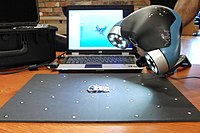
Photo from wikipedia
The advancement of digital holography in the past two decades has enabled precise capturing of three-dimensional (3-D) images of physical objects. This important technology has been widely applied in numerous… Click to show full abstract
The advancement of digital holography in the past two decades has enabled precise capturing of three-dimensional (3-D) images of physical objects. This important technology has been widely applied in numerous industrial sectors such as, but not limited to remote sensing, metrology, biomedical imaging, advertising, and entertainment. Most of the hologram acquisition techniques developed to date is employing digital cameras for recording the hologram, hence imposing rigid restrictions on the size and resolution of the captured 3-D image. This limitation, however, is not found in optical scanning holography (OSH). Based on a scanning mechanism and a single pixel sensor, OSH is capable of capturing digital holograms of both macroscopic and microscopic, as well as fluorescent objects with high precision. Since its invention in the late 70s, numerous research works have been conducted to enhance this technology, optimizing important factors such as acquisition speed, precision, data size, and security. The objective of this article is to provide a walkthrough of the state-of-the-art of the OSH technology, from its original principle, to different variants that have been developed over the years with emphasis on their feature extraction capabilities under the incoherent mode of operation. Whenever possible, we shall provide the key formulations of each approach, and experimental outcomes for demonstrating the pros and cons of the method.
Journal Title: IEEE Transactions on Industrial Informatics
Year Published: 2019
Link to full text (if available)
Share on Social Media: Sign Up to like & get
recommendations!